Rajaji - Elephant And Leopard In Tigerland
First published in Sanctuary Asia,
Vol. 43
No. 2,
February 2023
By Sipu Kumar, Rounak Patra, Navendu Page and Amit Kumar
The sudden cacophony of loud yapping calls from a nearby monkey biscuit tree Holoptelea integrifolia, heralded our first day in the Rajaji Tiger Reserve. Our attempt to track the source was interrupted by another familiar call… ‘ki-ki-ki-ki-ki-ki-ki-ki-ki-kee’. A Changeable Hawk Eagle was perched beside us on a bahera tree Terminalia bellirica. In the sharp grip of its long talons was an unidentifiable bird that had already been decapitated. Within seconds, three Oriental Pied-Hornbills took off from the monkey biscuit tree and positioned themselves strategically on different branches of another tree, closer to the eagle. A few more raucous calls rang out, but they left the eagle unimpressed as it continued to focus on its prized catch. As it dropped a few chunks of meat to the ground, an opportunistic hornbill swooped in, picked the meat with the tip of its large beak and gulped it down.
It was the Wildlife Institute of India’s (WII) first field survey in Rajaji after the COVID-19 pandemic had shut down all Protected Areas (PAs) in the country to researchers and tourists. On a rainy August morning, with seasonal rivers filled to the brim and the park vegetation showcasing its emerald best, we were our own company. Alert, yet ambling slowly along the slippery road, a colleague spotted a yellowish tinge in the middle of the road. Focussing our binoculars on the spot about 400 m. away, we saw a pair of watchful eyes staring back, its rosetted tail twitching… a leopard! We held our ground with controlled excitement. After a careful inspection of its intruders, the feline silently vanished into the foliage.
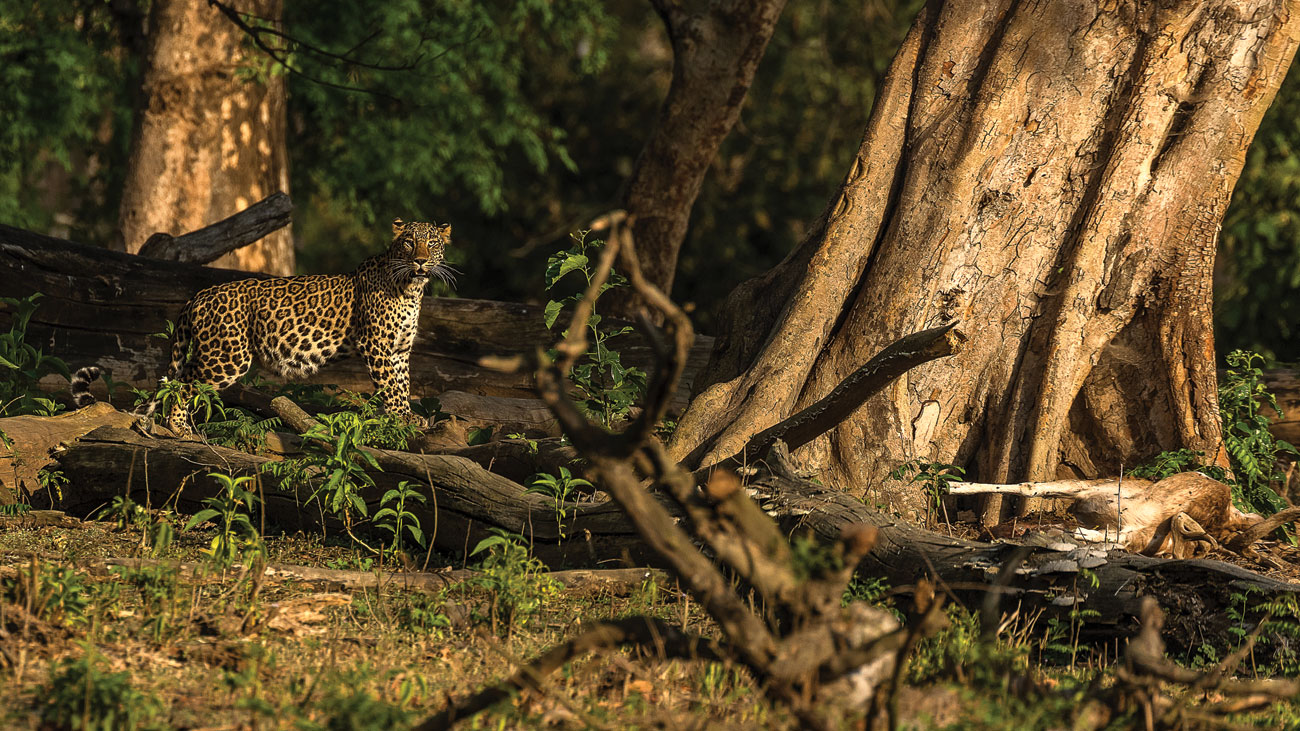
A leopard with a chital kill. The leopard population has expanded rapidly inside the Rajaji Tiger Reserve, possibly on account of the absence of a more dominant co-predator. Photo: Rounak Patra.
Since 2020, WII, in collaboration with the Uttarakhand Forest Department, has been studying the impact of invasive species on native flora, and unravelling the plant-animal interactions that promote their proliferation. Some of WII’s ongoing research has revolved around identifying major reserve areas where invasive species such as Lantana camara, Ageratum conyzoides, Parthenium hysterophorus, Cassia tora, to name a few, have crept in. Permanent plots were established systematically in different ranges of the tiger reserve for vegetation quantification. To understand the alteration of nutrient concentration, caused mainly by the notorious Lantana, soil samples were collected. Additionally, efforts were made to understand wild fauna interactions with native and invasive flora inside Rajaji. Line transects were laid in different forest ranges and walked repeatedly throughout the field work season to uncover if Lantana has altered the association between native plants and avian and mammalian frugivores. The Rajaji Forest Department has been diligently working to eradicate invasive species but their rapid proliferation makes it an extremely daunting task.
A Special Wilderness
When not busy with field work, we took the opportunity to record the tiger reserve’s biodiversity. The reserve is known for its large elephant herds that actively use the forested corridors connecting Corbett and Rajaji (Sanctuary Vol. XXII No. 3, June 2002). The big bulls use the Chilla-Motichur corridors across the Ganga river, and many can be seen around the reserve in the summer. While the exact population of these gentle giants is difficult to ascertain as the elephants are large-ranging species that are always on the move, it makes estimating their population a challenging task. Roughly 800-1,000 elephants are believed to reside in and around Rajaji, Corbett and the Shivalik Elephant Reserve. Encounters with them were a part of our daily routine as field work progressed. From our vehicles being mock-charged by wandering bulls, or being chased off while walking line transects, to silently observing a herd of almost 30 elephants cool themselves at a waterhole on a scorching summer afternoon, our experiences with these giants were surreal. A part of the staple diet of the elephant is the bark of the kumkum tree Mallotus philippensis; its shattering inadvertently functioned as an alarm bell, alerting us during our line transect and vegetation sampling surveys. Working in the evening also had its perks. On one occasion, we were stopped cold by an Asiatic black bear, possibly in search of wild honey, which suddenly made its appearance. Apart from camera trap images, our photographic records of black bears were possibly the first in-person confirmation-sightings in western Rajaji.
In December 2020, a pair of tigers from the Corbett Tiger Reserve was released in the Motichur range of Rajaji. At present, they shuffle between different ranges of western Rajaji. Radio-collared and constantly monitored by forest officials, the two are the only known resident tigers. Given the low tiger density, this opened up opportunities for another extremely adaptable feline that has dominated this landscape – the Indian leopard. It is sometimes hard to comprehend how dramatically the leopard population has expanded inside the reserve. One reason is the absence of a more dominant co-predator until very recently and the other could be the reduced human disturbance after Gujjar families were voluntarily relocated from the reserve to the Shivalik Elephant Reserve and other buffer zones. While traveling inside the reserve from one survey point to another, we sighted leopards 11 times in a single winter day. Handsome males, females with cubs, mating pairs, males competing for territory, and bone-chilling hunts by these fierce predators – we saw it all!
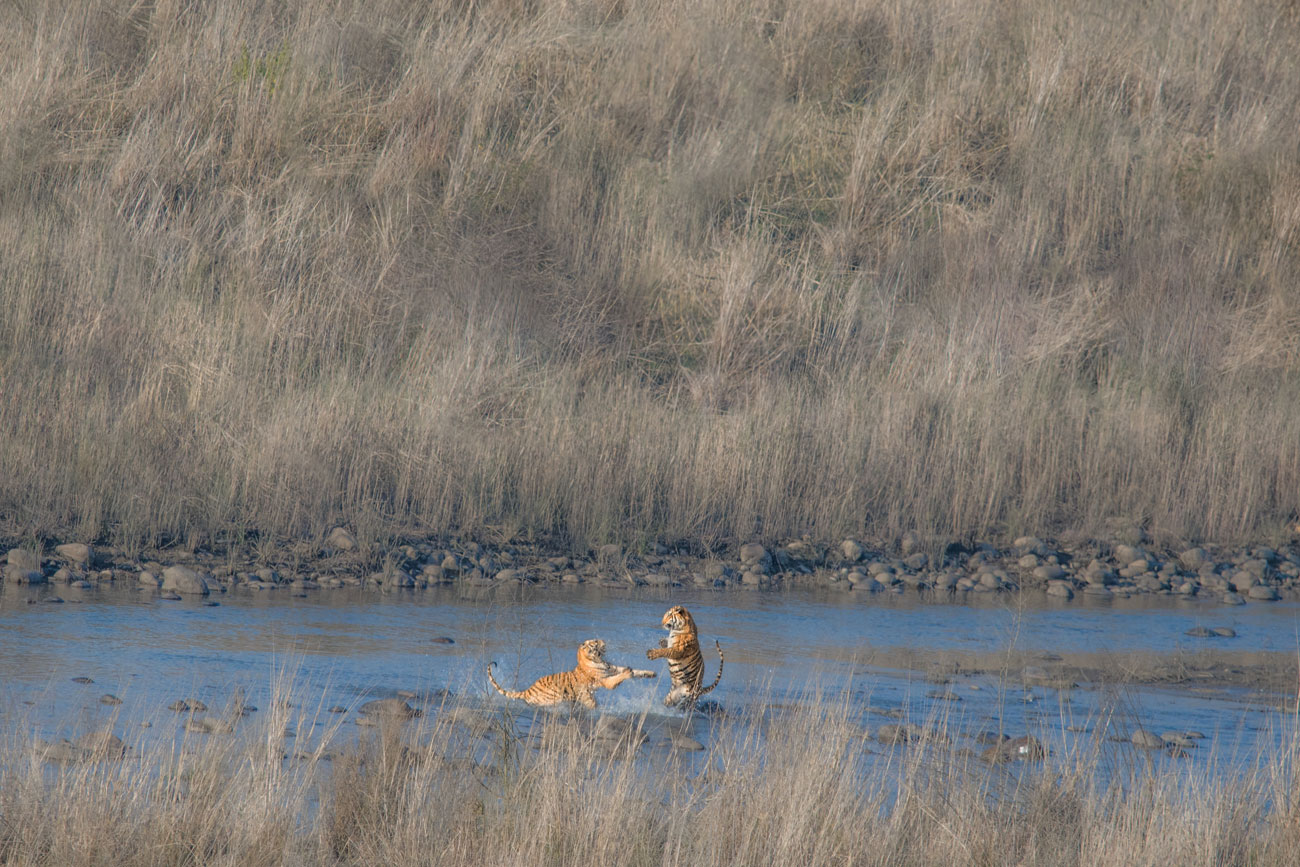
A duel between two tigers in a river in the Terai Arc Landscape. The reserve is home to around 37 tigers. Photo: Trikansh Sharma.
In a world where these predators have been pushed to the edges of their habitat and forced to take refuge in human-dominated landscapes, where they are often killed by speeding vehicles on newly-constructed roads, or slaughtered by angry mobs, Rajaji offers the spotted cats safe sanctuary. The night turns hauntingly beautiful when leopards move about our base camp, often lurking around the solar fences or lapping water on the far side of large water sources where elephants come to quench their thirst.
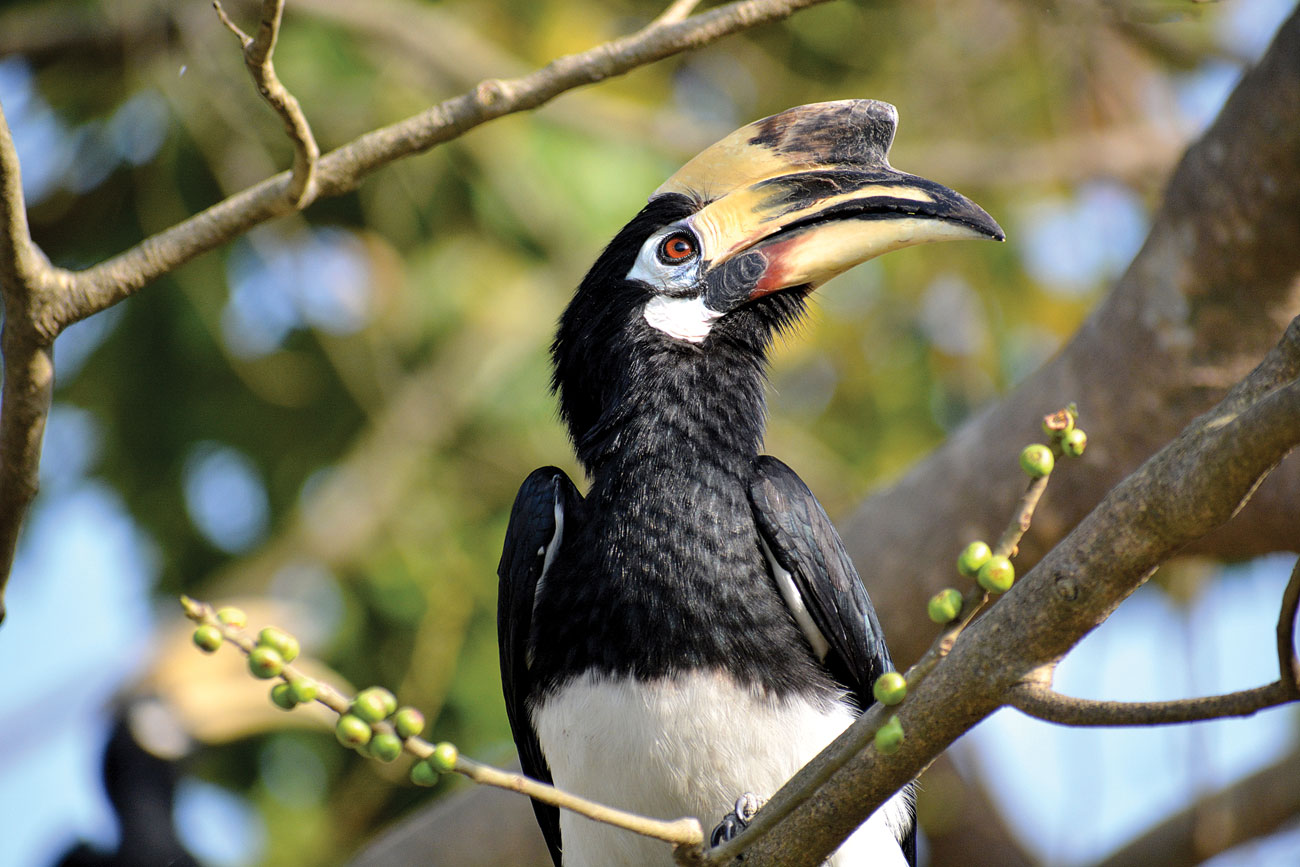
The Oriental Pied Hornbill Anthracoceros albirostris is a habitat specialist that mostly consumes fruit, and occasionally small animals. Photo: Sipu Kumar.
Birdlife Galore
Each day brought new surprises. We came across a striped hyena, photographed an albino sambar, fan-throated lizards and a king cobra. With an abundance of food to support a large prey base that thrives in these forests, herds of chital, sambar and nilgai were ubiquitous.
For plant lovers and botanists, Rajaji offers dense vegetation dominated by old-growth forests of sal Shorea robusta. Most of Rajaji falls under the category of tropical moist deciduous forest, with trees such as Ficus rumphii., Bombax ceiba, Butea monosperma, Erythrina variegata, Terminalia spp., Holoptelea integrifolia, Dalbergia sissoo, Cassia fistula and Mallotus philippensis, all commonly seen throughout the reserve. The rare and endemic Catamixis baccharoides of Shivalik hills that grows only in rocky cliff areas, was also documented during one of our field surveys. Apart from the natural vegetation, a small nursery is maintained inside the park, which specialises in growing native grasses to provide food for herbivores and to replace vegetation lost during forest fires.
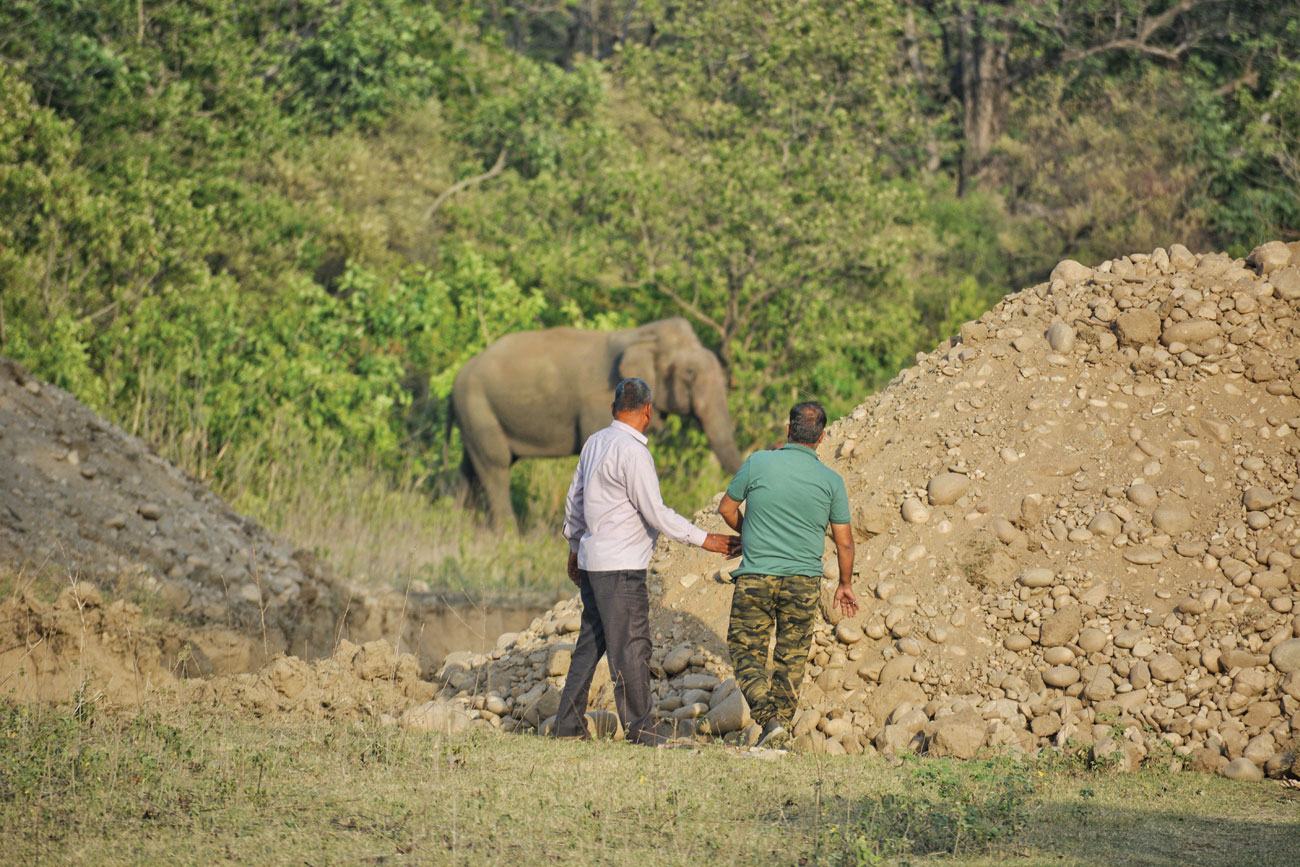
Surprise encounters with elephants, as experienced by these forest staff while constructing a waterhole, is common in Rajaji, known for its large elephant population. Photo: Sipu Kumar.
Over an entire survey season that spread across summer, winter and the beginning of the monsoons, we saw an abundance of birdlife in and around the reserve, from the drumming of the elusive Great Slaty Woodpecker – the largest woodpecker species in the world – to Great Hornbill flocks that thrive in the undisturbed, dense forested parts of Rajaji, and even an albino Jungle Babbler. Our field visits recorded almost 13 species of woodpeckers. Interestingly, the reserve harbours a significant population of two critically endangered vultures – Cinereous (a winter migrant) and Red-Headed (a resident) – and the endangered Steppe Eagle (another winter migrant). Apart from that, Changeable Hawk Eagles, Crested Serpent Eagles, White-eyed Buzzards and Peregrine Falcons are seen throughout the year. During summer, the breeding songs of the Indian and Hooded Pitta were heard through the forests. As dusk settled, vivid calls and flights of Savanna Nightjars and Large-tailed Nightjars could be heard and seen throughout. Nights are for owl lovers; our sightings ranged from the Brown-hawk Owl to calls of Oriental and Collared Scops Owls and Brown Wood Owls.
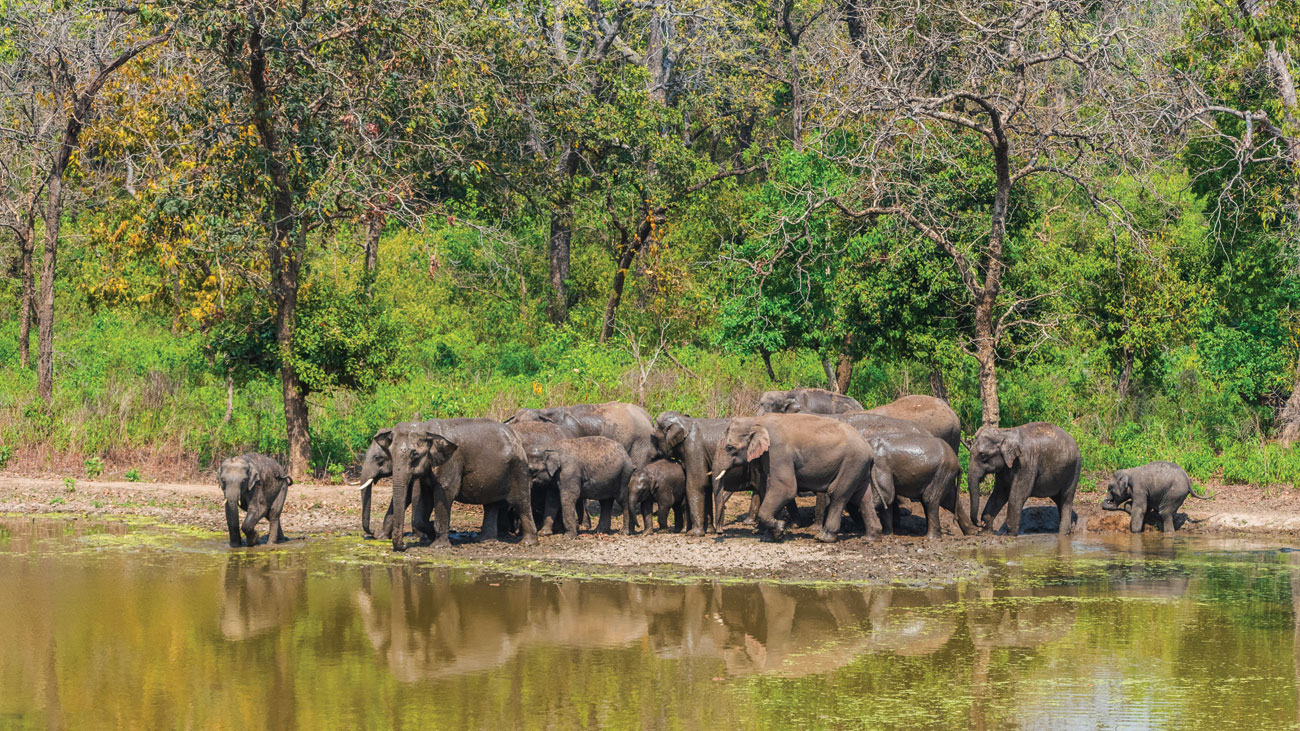
A herd of Asian elephants cool off at a waterhole. The authors had several memorable encounters with the large pachyderms during their field visits in the Rajaji Tiger Reserve. Photo: Rounak Patra.
What Does The Future Hold?
In hindsight, our time spent surveying the Rajaji Tiger Reserve was an eye-opener. While on one hand we faced difficulties staying in a camp that lacked even basic amenities, it helped us understand the challenges faced by the forest staff, who are mandated to protect parks by way of daily patrols, with the attendant risk of wildlife attacks. Down the years, Uttarakhand has witnessed rapid urbanisation, with a heavy influx of religious tourists, trekkers, bikers and weekenders visiting Rajaji in virtually every season. Easy access provided by its location, connected by roads that link suburban towns, and large cities such as Rishikesh, Dehradun and Haridwar has turned the Rajaji Tiger Reserve into a tourist haunt. In the process elephant corridors have been disrupted and road kills have increased manifold. Even then, development is a runaway train that waits for none. As researchers and conservationists, our job focuses on finding mitigation measures that suit both wildlife and the people residing in these areas. A prime example of this includes the construction of a major highway linking Delhi to Dehradun by the National Highway Authority of India through the Ganeshpur-Dehradun (NH-72A), that cuts through a vital wildlife corridor. The authorities say this will reduce the journey time from 6 to 2.5 hours from New Delhi. While the initial decision was to expand the existing highway that would have paved way for a larger destruction of forests and roadkills, an elevated corridor of 12 km. and a 340 m. tunnel was found to be an effective solution. Though the immediate impacts of construction cannot be evaded, the long-term consequences of an elevated road will actually help reduce habitat fragmentation and bolster connectivity, as animals will be able to pass without any disturbance through the underpass. Additionally, Uttarakhand’s Shivalik Elephant Reserve, set up in 2002 under ‘Project Elephant’, was to be denotified in November 2020, but fortunately was blocked when the Uttarakhand High Court issued a stay order after a Public Interest Litigation (PIL) was filed pleading the court to stop the process.
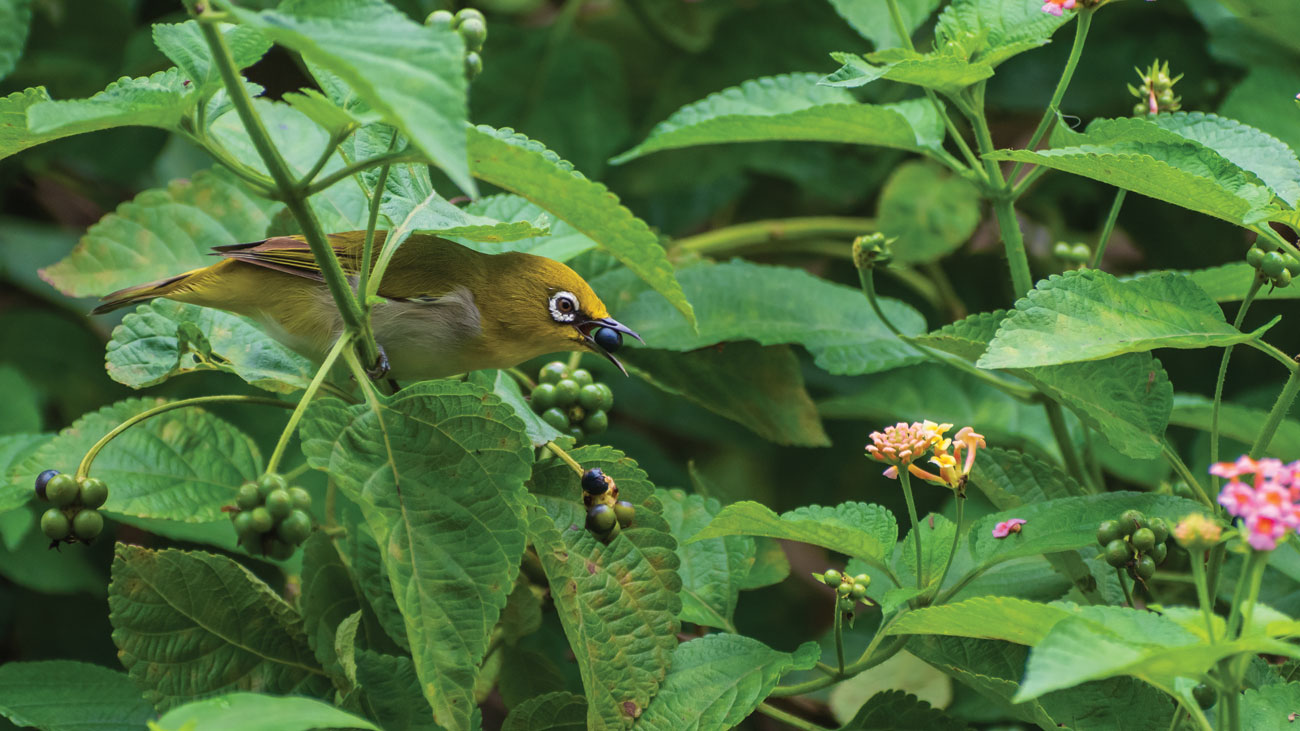
The rapid spread of the invasive plant Lantana camara has led to an increase in generalist species like the Indian White-eye Zosterops palpebrosus. Photo: Rounak Patra.
On the outside, Rajaji continues to face anthropogenic pressures, thanks to incessant developmental activities. As the government focuses on more commercial infrastructures, planners seem to have forgotten the most valuable infrastructure, which protects Haridwar, Dehradun, Saharanpur and Rishikesh, is Rajaji. These projects will enrich only the contractors, while whittling away at the ecological foundations of Rajaji.
The Terai Arc Landscape – a vast area between the rivers Yamuna in the west and Bhagmati in the east – comprises the Shivalik hills, Bhabhar region and the Terai floodplains. This unique landscape harbours three major flagship species – the Bengal tiger, Asian elephant and the one-horned rhinoceros. In the Shivalik hills, Rajaji National Park and Jim Corbett National Park form a dominant part of the western Terai Arc Landscape, and are home to the tiger and elephant. The Rajaji National Park, named after the Indian statesman, lawyer, writer and freedom fighter C. Rajgopalachari, was established in 1983 – an amalgamation of three previously recognised reserves namely, Rajaji Wildlife Sanctuary, Motichur Wildlife Sanctuary and the Chilla range of the erstwhile Pauri Forest Division. In 2015, the National Tiger Conservation Authority declared the park as a tiger reserve to provide maximum protection to this 820.42 sq. km. forest.
Thus far, this little appreciated wilderness has withstood the assaults unleashed on it. But scientists warn that a tipping point is drawing near and that the price paid for unbridled economic development might well undermine the economies of lakhs of people, possibly even threaten the holiest of cities and townships that emerged because of the veneration that our ancients felt for the Himalaya and its outlying forests and rivers such as the Ganges and the Yamuna. Today this iconic forest has paved the way for several research projects on flagship species, and has served as a platform for scores of field-based researchers whose on ground training has turned them into sensitive forest officers and conservationists. We must all unite in defence of Rajaji, its wild denizens and the local communities that depend on it for their survival.
The authors are thankful to the Uttarakhand Forest Department, especially the Field Director and forest staff of Rajaji Tiger Reserve, and grateful to Dr. Dhananjay Mohan for his insights, DST-SERB for funding the research project, and Vijendra Kumar for assisting in the field.
Sipu Kumar is a Ph.D. Scholar at the Wildlife Institute of India (WII), mainly interested in understanding plant-animal interactions. Rounak Patra is an avid birdwatcher as well as photographer, whose research interests include the community ecology of birds and their response to climate change. Navendu Page is a scientist at WII, who is deeply interested in natural history, evolution and field botany. Amit Kumar, a scientist at WII, has been exploring the Himalayan region and Shiwaliks to understand vegetation patterns and plant associations.







